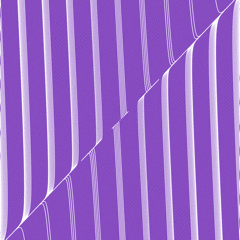Eigencurves
Linear algebra is one of my favourite areas of mathematics. Its a simplification but you could say that the things that mathematics does well are small numbers and straight lines. The rest is just clever ideas to covert other things into those. As the mathematics of straight lines and flat surfaces, the importance of linear algebra should be clear. Its techniques are also very fast when done on a computer, allowing live motion in video games. This lead to every computer having a GPU, essentially a special chip for linear algebra.
Within linear algebra a central object is the linear transformation (that can be encoded as matrices) and the subspaces it preserves given by the eigenvectors. This gives some powerful tools to break linear transformations into pieces that can be studied more easily. As well as eigenvectors, however, linear transformations that do not have negative real eigenvalues preserve other families of curves. Curves that are taken to themselves by the transformation. These animations show how these curves change as the matrix changes. Giving a glimpse into the detail of what linear transformations do. These are of particular interest in dynamical systems where these images so some of behaviours possible close to a fixed point.
OMOOS
This animation shows a pair of eigenvalues changing from complex (creating a rotation and scaling) into real values. Can you tell where it happen? It uses the matrix
with s running from 1.05 to 4.05.
SOOS
This animation shows a hyperbolic fixed point (attracting in one direction and repelling in another) changes into a attracting equilibrium point, using the matrix
with s running from 1.05 to 4.05.
OSOTS
This animation shows a transformation changing as both the eigenvalues and the direction of the eigenvectors, using the matrix
with s running from 0.05 to 3.05.
OOOS
This animation shows a transformation changing as both the eigenvalues and the direction of the eigenvectors, using the matrix
with s running from 1.05 to 4.05.
SOZS
This animation shows how a shear changes with different eigenvalues, using the matrix
with s running from 0.05 to 3.05.






Can you post source code?
They are made in mathematica, though not prettied up. I can send you the notebook if you send me an email.
I disagree with your first point … I would say 19th century algebraists (cayley, sylvester, ………) dealt with basic multi-dimensionality. Homotopy etc was also successful in the 20th century but, linear algebra is more about resolving the issue of high number of variables, when their interactions are as simple as can be……
various groups (again 19th / early 20th cent successes … burnside) are curved or tree’d or …… and mathematics has been successful with those as well
Not sure which piece you disagree with, but would definitely include higher dimensional planes in my loose description of “straight lines”. Trees are definitely a great example of how this is an oversimplification, as I state. I think of much of group theory fitting in a “small numbers” collection, but so many powerful ideas productively take algebraic ideas into geometry and vice versa that that is not clear either.